
Nabis - I
Nabis
The Nabis (French: les nabis, French pronunciation: [le nabi]) were a group of young French artists active in Paris from 1888 until 1900, who played a large part in the transition from Impressionism and academic art to abstract art, symbolism and the other early movements of modernism. The members included Pierre Bonnard, Maurice Denis, Paul Ranson, Édouard Vuillard, Ker-Xavier Roussel, Félix Vallotton, Paul Sérusier and Auguste Cazalis. Most were students at the Académie Julian in Paris in the late 1880s. The artists shared a common admiration for Paul Gauguin and Paul Cézanne and a determination to renew the art of painting, but varied greatly in their individual styles. They believed that a work of art was not a depiction of nature, but a synthesis of metaphors and symbols created by the artist. In 1900, the artists held their final exhibition and went their separate ways.
Paul-Elie Ranson
1861 - 1909
Paul Ranson (March 29, 1864 – February 20, 1909) was a French painter and writer.
Paul-Elie Ranson was born in Limoges and studied at the École des Arts Décoratifs there before moving to Paris and transferring to the Académie Julian in 1886. There he met Paul Sérusier in 1888. Subsequently, from 1890 he became a member and a creative leader of the Nabis group. They gathered at his studio in the Boulevarde du Montparnasse each Saturday. He was the one who introduced the Nabis language within the group.

Portrait of Paul Ranson by Paul Sérusier

Untitled

Untitled

Untitled

Untitled

Untitled

Paesaggio Nabi

Deux Nus

Untitled

Untitled

Untitled

Untitled

Untitled

Untitled

Untitled

Untitled

Untitled
Félix Édouard Vallotton
1865 – 1925

Félix Édouard Vallotton (December 28, 1865 – December 29, 1925) was a Swiss and French painter and printmaker associated with the group of artists known as Les Nabis. He was an important figure in the development of the modern woodcut. He painted portraits, landscapes, nudes, still lifes, and other subjects in an unemotional, realistic style.
His earliest paintings were influenced by Holbein and Ingres. He developed a simpler style during his association with Les Nabis during the 1890s, and produced woodcuts which brought him international recognition. Characterized by broad masses of black and white with minimal detail, they include street scenes, bathers, portraits, and a series of ten interiors titled Intimités (Intimacies) that portray charged domestic encounters between men and women. He produced few prints after 1901, and concentrated instead on painting. His later paintings include highly finished portraits and nudes, and landscapes painted from memory.

The Patient (1892)
_MET_DT3331.jpg)
Street Scene in Paris (1895)

The Red Chamber (1898)

The Ball (1899)

Three Women and a Little Girl Playing in the Water (1907)

Sleep (1908)

The Visit (1899)

The Bath. Summer
1892

The Rape of Europa
1908
.jpg)
Interior with Couple and Screen (Intimacy), 1898

Nude Playing Cards
1912

Lady and Her Maid
1896

Akt in rotem Zimmer
1897

Nude Blond Woman with Tangerines
1913

Blooming Fields (1912)

Woman with a Black Hat
1908

Street Scene
1897

Nude at the Stove
1900

Still Life with Gladioli
1924

Frauenakt mit Papagei

Waltz (1893)

La Blanche et la Noire (1913)

Blonde Nude (1921)
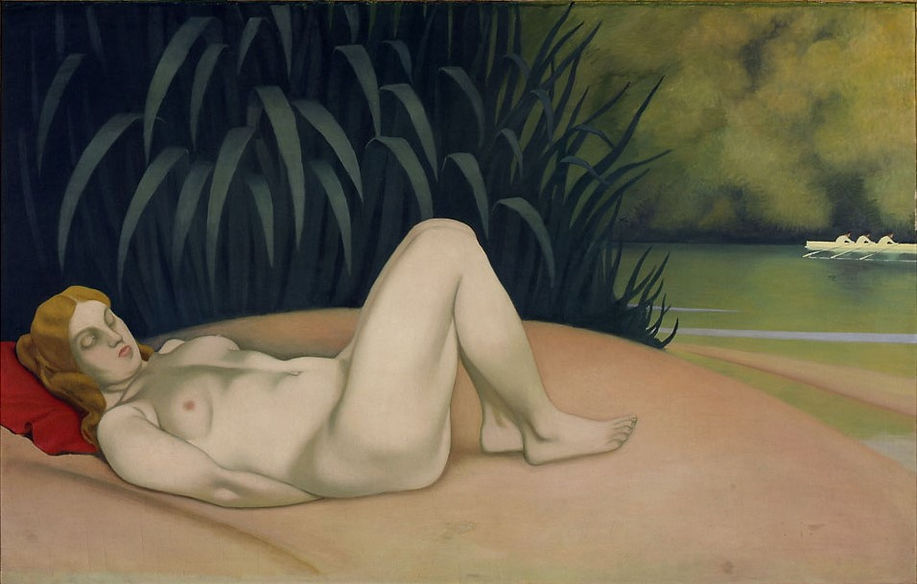
Femme nue dormant au bord de l'eau, 1921

Women at Their Toilet Femmes leur toilette
1897

Naked Women with Cats
c.1897 - 1898

Last rays of sunshine (1911)

Intimate Couple in Interior
1898
Pierre Bonnard
1867 –1947
Bonnard Pierre (1867—1947). French painter, lithographer and designer who studied at the Ecole des Beaux-Arts (1888) and the Academic |ulian (1889). While a student he met Serusier, Vallotton, Vmllard and the other Nabis who first exhibited together at the Cafe Volpini m 1889. His early graphic work (Ret'iie Blanche cover, 1 89s) combines acute and often humorous observation of a fleeting pose with an instinctive sense of design. I le ill. a number of books for *Vollard including Parallelemeiil (1900) and the outstanding edition of Daphnis et Chloe' (1902). His decorative use of silhouette reflects the widespread influence of Art Noureau and of Japanese prints. He subscribed to the Nabis doctrine of abandoning 3-dimensional modelling in favour of flat colour areas, but was never committed to the Symbolist aspect of the movement.
After 1900 he concentrated more on painting and although he still worked more from his observation than his imagination, his early wit and charm gave way to a Matisse-like monumentahty of design. Mature works like La Baignoire (1925) play off the considerable surface richness of paint and colour against a simple formal strength and bis acute perception of light. After 1911 he worked either at Vernon or in S. France.

Self-Portrait
1889

Last self-portrait (1945)

Woman with Dog 1891

The Croquet Game
1892

Eisbahn
1898

The Luncheon
1899

Indolence
1899

Siesta
1900

Nude against Daylight
1908

The Loge
1908

Place Clichy
1912

Bathing Woman
1919

Interior with a Woman in a Wicker Chair
1920

Nude Washing Feet in a Bathtub
1924
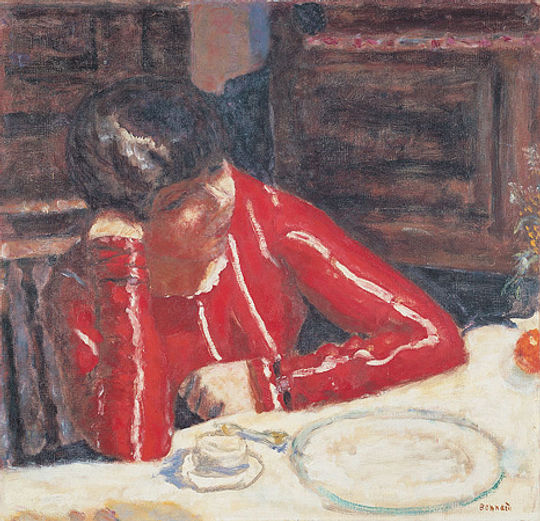
The Red Blouse
1925
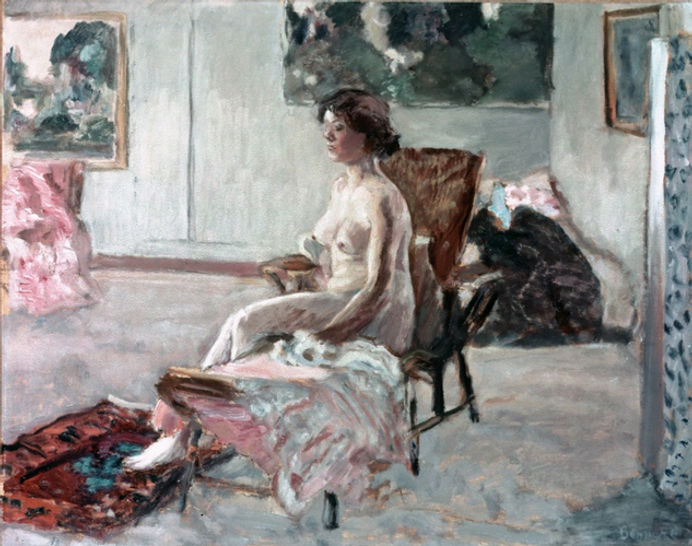
Nackte sitzende Frau

Nackte Frau im Zimmer

Family
1893

Intimite
1891
Musee d'Orsay, Paris

La petite blanchisseuse

Child with Lamp
1897

Promenade des Nourrices
1899

Man and Woman
1900

Woman Bending Over
1907

Das Fruhstuck
1907

The Bathroom Mirror
1908

Cherry Pie
1908

Girl with Parrot
1910

Dining Room in the Country
1913

Nude

Nude in Front of the Mantlepiece
1919

Das Fruhstuck
1922

Getting out of the Bath
1930
.jpg)
Madchenakt
1930

The Bathroom
1932

Bather
1935
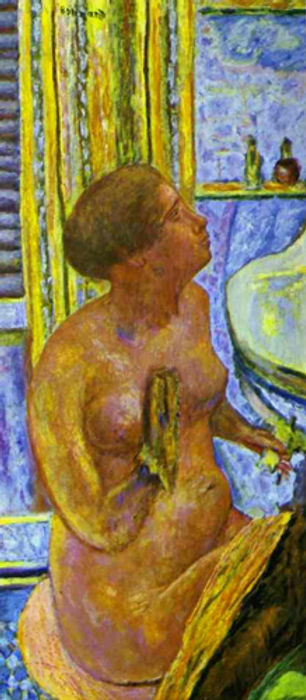
Horse-Hair Glove
1939

The Terrace at Vernonnet
1939

Almond Tree in Blossom
1945

Nude in the Bath and Small Dog, (c. 1946)
Jean-Édouard Vuillard
1868 – 1940

Jean-Édouard Vuillard (11 November 1868 – 21 June 1940) was a French painter, decorative artist and printmaker. From 1891 through 1900, he was a prominent member of the Nabis, making paintings which assembled areas of pure color, and interior scenes, influenced by Japanese prints, where the subjects were blended into colors and patterns. He also was a decorative artist, painting theater sets, panels for interior decoration, and designing plates and stained glass. After 1900, when the Nabis broke up, he adopted a more realistic style, painting landscapes and interiors with lavish detail and vivid colors. In the 1920s and 1930s he painted portraits of prominent figures in French industry and the arts in their familiar settings.
Vuillard was influenced by Paul Gauguin, among other post-impressionist painters.
Self-Portrait

Child Wearing a Red Scarf
1891

Woman at Her Toilette
1891

The Conversation
1891

Madame Hessel in her Salon

Madame Hessel in her Salon

Place Saint-Augustin
1913

Frau im Atelier
1913

Le Vase Bleu
1930
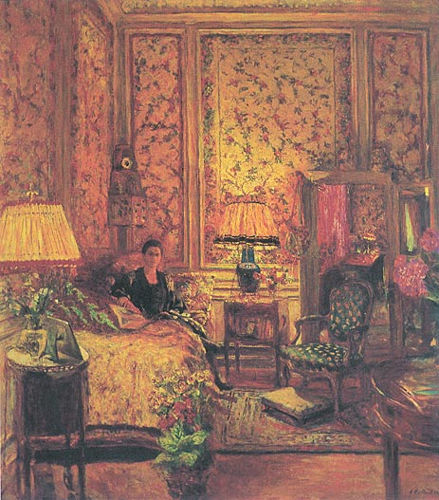
The "Voiles de Genes" Boudoir
1931

The Visit
1931

Bildnis der Dichterin Noailles
1932
Maurice Denis
1870 – 1943
Maurice Denis b Granville, 25 Nov 1870; d Paris, 13 Nov 1943.
French painter, designer, printmaker and theorist. Although born in Normandy, Denis lived throughout his life in Saint-Germain-en-Laye, just west of Paris. He attended the Lycée Condorcet, Paris, where he met many of his future artistic contemporaries, then studied art simultaneously at the Ecole des Beaux-Arts and at the Académie Julian (1888–90). Through fellow student Paul Sérusier, in 1888 he learnt of the innovative stylistic discoveries made that summer in Pont-Aven by Paul Gauguin and Emile Bernard. With Sérusier and a number of like-minded contemporaries at the Académie Julian—Pierre Bonnard, Paul Ranson, Henri-Gabriel Ibels and others—Denis found himself fundamentally opposed to the naturalism recommended by his academic teachers. They formed the NABIS, a secret artistic brotherhood dedicated to a form of pictorial Symbolism based loosely on the synthetic innovations of Gauguin and Bernard. Denis’s first article, ‘Définition du néo-traditionnisme’, published in Art et critique in 1890 (and republished in Théories), served almost as a group manifesto and gave a theoretical justification for the practical and technical innovations of the Pont-Aven school. With its opening statement, ‘It is well to remember that a picture, before being a battle horse, a nude woman, or some anecdote, is essentially a flat surface covered with colours assembled in a certain order’ (frequently quoted out of context), Denis contributed to the development of a formalist, modernist aesthetic in the 20th century. The bold experiments in flat paint application and anti-naturalistic colour that characterized his early Nabi work seemed to prefigure later abstract initiatives. Both as an artist and as a theorist, however, Denis retreated from the radical position he had adopted as a student in 1890. He had never denied the importance of subject-matter, and in his later painting he devoted himself to the revival of religious imagery.

Autoportrait devant le Prieuré

Mother and Child
1890

The Two Sisters
1891
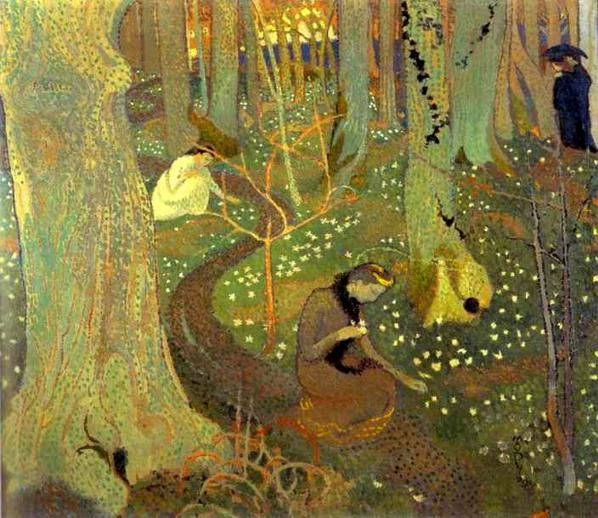
Easter Morning or Easter Mystery
1891

Regata at Perros
1892

L'echelle dans le feuillage
1892

Mystic Allegory
1892

Beauty in the Autumn Wood
1892

Triple Portrait of Marthe
1892

Wedding Procession
1892

April
1892

The Sleeper or Young Girl Asleep
1892

The Muses in the Sacred Wood
1893

Mary Visits Elizabeth
1894

Noli Me Tangere
1895

Martha and Mary
1896
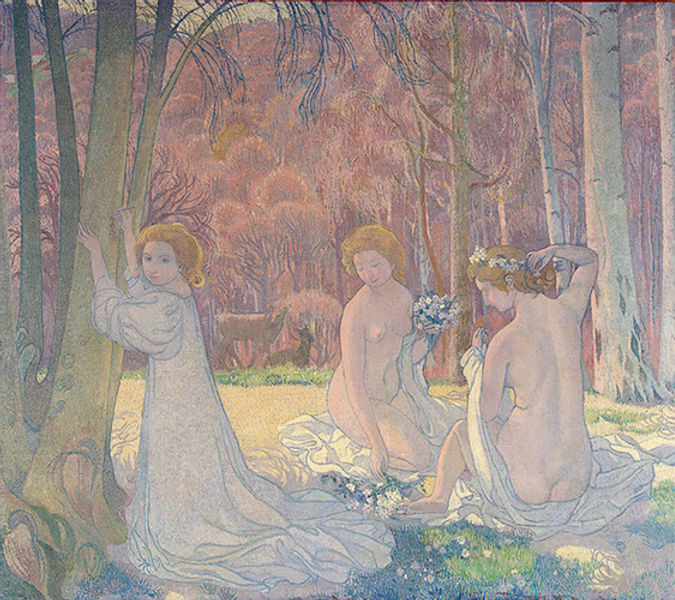
Figures in a Spring Landscape
1897

Springtime
1897

Nude with Bouquet of Violets (1894)

Miss Yvonne Lorelle in Three Poses
1897

Amour
1898

Homage to Cezanne
1900

Euridice
1905

Bacchus and Ariadne
1907

Wave (1916)

Polyphemus (1907)

Bathers at Perros Guirec (1912)

The Story of Psyche
1908-1909
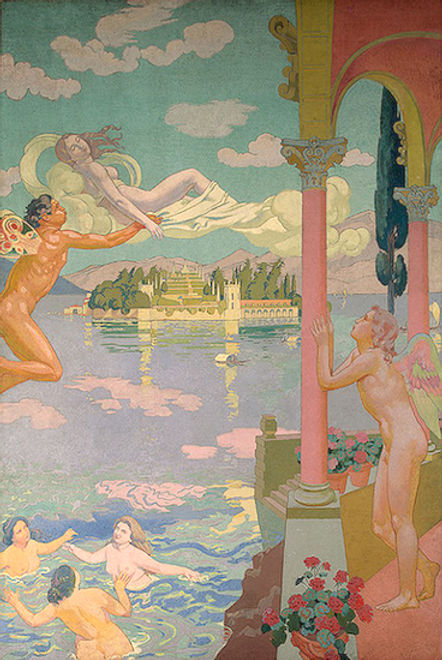
The Story of Psyche
1908-1909

The Story of Psyche
1908-1909
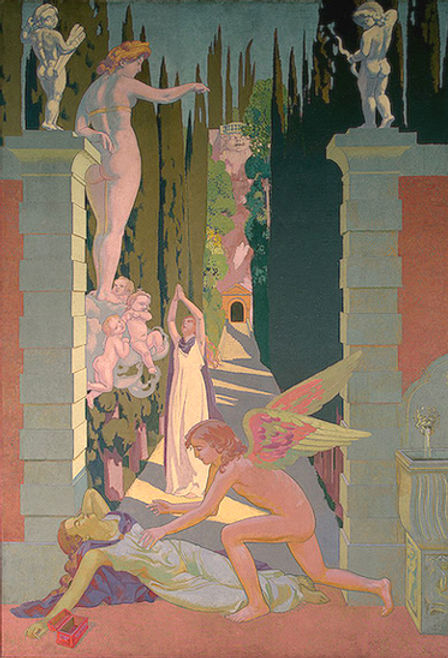
The Story of Psyche
1908-1909
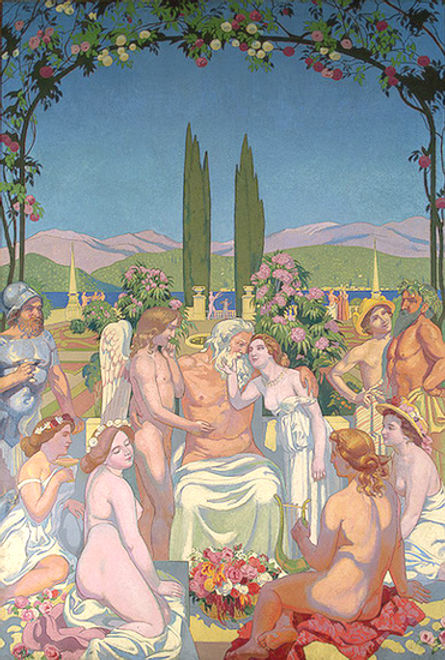
The Story of Psyche
1908-1909

The Story of Psyche
1908-1909

The Story of Psyche
1908-1909